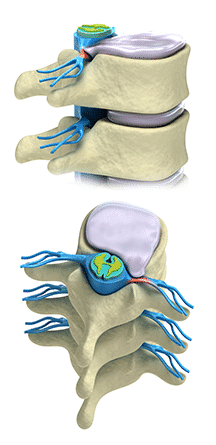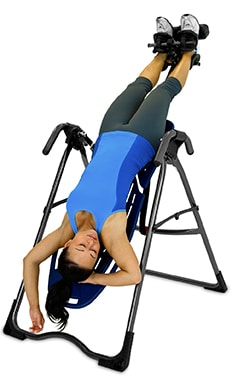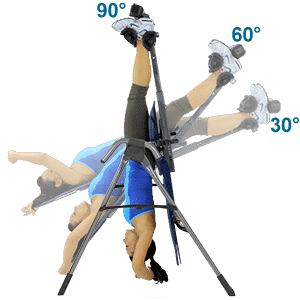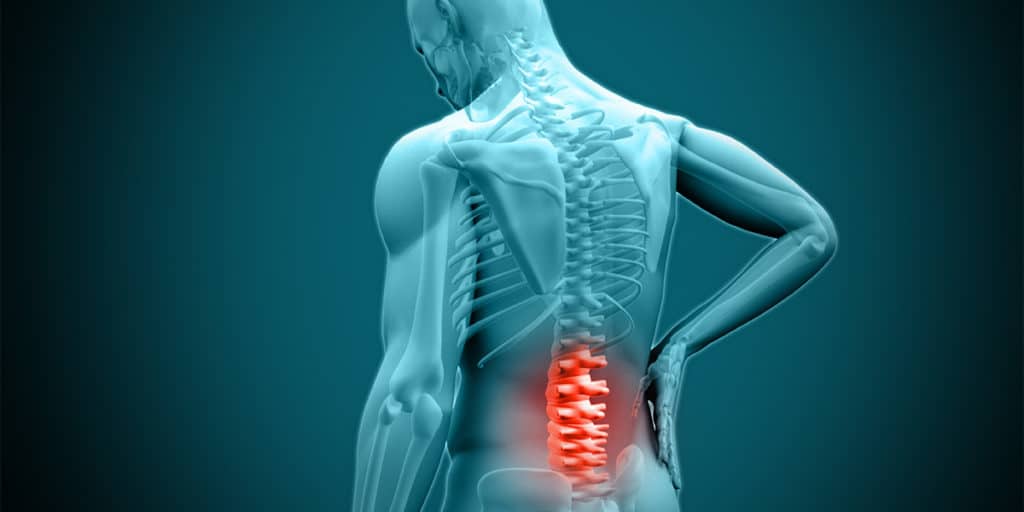Having a herniated disc, also called a slipped disc, bulging disc or ruptured disc, can be very painful. Relief from the pain is a high priority for anyone suffering from this condition. Thankfully, there is a natural, non-invasive option that has been shown effective in numerous studies: inversion therapy (or inverted decompression). There is an FDA Registered 510(k) Medical Device that you can use in your own home to relieve disc-related back pain.
First, we’ll look at the condition and what causes it, then explore this effective form of pain relief for herniated discs.
What is a Herniated Disc?

Each disc has a tough exterior and a squishy center (they often get compared to jelly donuts or Twinkies). A herniated disc is one that is protruding from between the vertebrae in the spine. Sometimes the exterior section ruptures or tears and the squishy center leaks out. This can put pressure on the nerves that exit the spine, causing inflammation, numbness, weakness and radiating pain.
Herniated discs usually occur in the lower back. Occasionally patients may have herniated discs in the cervical spine.
Relief Options for a Herniated Disc
Relieving herniated disc pain span conservative to aggressive options. On the conservative end are medications (which have their own serious side-effects), physical therapy, alternative methods such as massage or yoga, and inversion therapy.
Aggressive options include any type of back surgery. Only a small number of patients with herniated discs are recommended for surgery and generally, doctors recommend pursuing conservative therapy first. In fact, a recent preliminary study found that herniated disc patients who inverted were 70% less likely to need surgery than those who pursued standard physiotherapy alone – continue reading to learn more!
Preliminary controlled study, 24 patients, various Teeter models used 3x/week for four weeks, up to six 2-minute inversions/session. “Inversion Therapy In Patients with Pure Single Level Discogenic Disease: a pilot randomized trial. Majhunath, et al. Newcastle General Hospital, Newcastle Upon Tyne, UK
How does Inversion Therapy Help a Herniated Disc?

The act of widening the space between vertebrae provides more room for the nerves that exit the spine – less pressure means less pain. And the decompression may actually create a suction effect, ‘encouraging’ the disc to its proper shape.
As previously mentioned, inversion therapy has actually been shown to reduce the need for surgery in patients with herniated discs.
A preliminary, controlled study was conducted by researchers at Newcastle Hospital.1 The study involved 24 patients waiting for lumbar disc surgery. The patients were separated into two groups. Both groups received routine physiotherapy, while the experimental group also received inversion therapy on a Teeter Inversion Table.
The researchers at Newcastle concluded that “intermittent traction with an inversion device resulted in a significant reduction in the need for surgery.” Study participants using the Teeter Inversion Table were 70% less likely to need surgery!

Aside from benefiting patients with herniated discs, inversion has been shown to relieve back pain and other conditions like sciatica, degenerative disc disease, muscle spasms and more.
Muscle pain is often a side effect of back pain conditions originating in the spine since the body tenses up to help protect the injured area. In one study measuring muscle pain via EMG activity, researchers cited the increase in spinal length while inverted to a statistically significant reduction in pain – in fact, EMG activity declined over 35% within 10 seconds of inverting!
To optimize the benefits of inversion therapy for your herniated disc, or any other back pain conditions, you will want to work up to inverting at a 60-degree angle. But don’t worry, you can work up to it over time, and you’ll start feeling the benefits even at a shallow angle of 30 degrees!
As with any other exercise program, you should consult your doctor before beginning and listen to your body as you perform the movements and stretches.
Find Relief Now. Pay Later.
Now you can try Teeter in your own home FREE for 30-Days, 0% APR* with Affirm.
